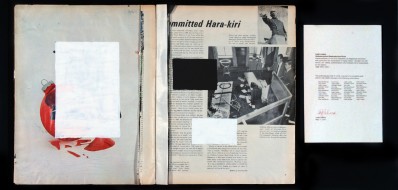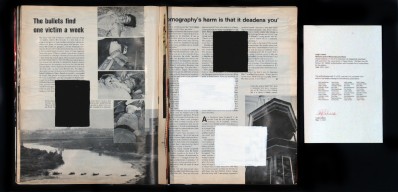Leigh Ledare
A Modest Exchange, Apr 2011
curated by Tom Eccles
1968-1972 / 2011
Reworked Life Magazines (from the subscription of Mr. Selig Paskin, 138 Glen Ave, Mt Vernon, NY 10550), published list of contingent subscribers’ names.
15 x 30 inches
Edition of 50 unique works and 10 unique A.P.
***
Leigh Ledare’s A Modest Exchange functions as 60 fragments of one larger piece. Its formal structure and dissemination is meant to elude visibility in its entirety.
Beginning with an already fulfilled subscription – a collection of Life Magazines obtained by Mr. Selig Paskin through mail between the years of 1968-1972 – Ledare intervened within the limitations of the bound magazine’s facing-page format. Excising pages in order to reveal latent juxtapositions, Ledare’s removal criteria looked for combinations used to justify the limiting and forfeiting of individual privacy. The addition of a black and white painted geometric overlay functions as a broad abstract structure that optically links all the parts of the complete work while pitting itself against the initial content and layout of the magazines. This simple form comprises both an additive and reductive device, implying a secondary layout, and echoing the surplus of meaning created through the paradoxical subtraction of pages. The two levels of obliteration dovetail.
Both in the form of the complete mural size work, and in each of the 60 editions, the initial magazine content invokes a social history and cultural past foundational to our contemporary moment. The black and white rectangles function as placeholders, screens to project onto, concealing, reordering, and pointing, through putting into play figure and ground, paint and support, past and present, and mirroring the perpetually redundant replacement of old image with new. As a mise en abyme of Life’s own editorial formula, Ledare’s gesture critically editorializes, but at a structural level.
The period of Life’s demise as a weekly magazine in 1972, in sync with the advent of focus groups and target marketing, signaled an inversion of longstanding consumer practices. The advertising industry’s power to manipulate consumers through the collection and exchange of private information saw unprecedented development. With the aim of firmly fixing ongoing consumption patterns, producers began to implement diverse methods to uniquely gratify the customer. As a result, the long term potential each consumer represents increasingly matured in value over the objects exchanged. The corporation’s goal became to make the consumer a subscriber to a brand. The vehicle was the promise of a distinct lifestyle.
By dividing A Modest Exchange through its sale as a subscription, Ledare enacts the dissolution of the work as a whole, and refuses its complete representation. In this sense each issue of the subscription exists not as an autonomous piece but as a fragment accompanied by a list of the contingent subscribers’ names. This list will be updated until the entire subscription’s sale is complete. Functioning as an information system the list of subscribers replaces the actual missing whole, and diagrams the work’s dispersion into the marketplace. In turn, the mutilated, painted and re-distributed magazine as art object functions as fetish, metonymically linking us to larger systems of production, desire, consumption and exchange, and their historicity.











